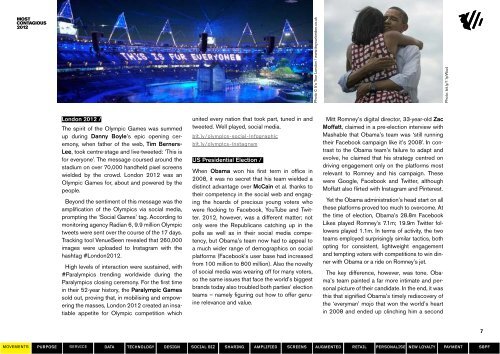MostContagious2012.pdf - Contagious Magazine
MostContagious2012.pdf - Contagious Magazine
MostContagious2012.pdf - Contagious Magazine
You also want an ePaper? Increase the reach of your titles
YUMPU automatically turns print PDFs into web optimized ePapers that Google loves.
London 2012 /<br />
The spirit of the Olympic Games was summed<br />
up during Danny Boyle’s epic opening ceremony,<br />
when father of the web, Tim Berners-<br />
Lee, took centre-stage and live-tweeted: ‘This is<br />
for everyone’. The message coursed around the<br />
stadium on over 70,000 handheld pixel screens<br />
wielded by the crowd. London 2012 was an<br />
Olympic Games for, about and powered by the<br />
people.<br />
Beyond the sentiment of this message was the<br />
amplification of the Olympics via social media,<br />
prompting the ‘Social Games’ tag. According to<br />
monitoring agency Radian 6, 9.9 million Olympic<br />
tweets were sent over the course of the 17 days.<br />
Tracking tool VenueSeen revealed that 260,000<br />
images were uploaded to Instagram with the<br />
hashtag #London2012.<br />
High levels of interaction were sustained, with<br />
#Paralympics trending worldwide during the<br />
Paralympics closing ceremony. For the first time<br />
in their 52-year history, the Paralympic Games<br />
sold out, proving that, in mobilising and empowering<br />
the masses, London 2012 created an insatiable<br />
appetite for Olympic competition which<br />
united every nation that took part, tuned in and<br />
tweeted. Well played, social media.<br />
bit.ly/olympics-social-infographic<br />
bit.ly/olympics-instagram<br />
US Presidential Election /<br />
When Obama won his first term in office in<br />
2008, it was no secret that his team wielded a<br />
distinct advantage over McCain et al. thanks to<br />
their competency in the social web and engaging<br />
the hoards of precious young voters who<br />
were flocking to Facebook, YouTube and Twitter.<br />
2012, however, was a different matter; not<br />
only were the Republicans catching up in the<br />
polls as well as in their social media competency,<br />
but Obama’s team now had to appeal to<br />
a much wider range of demographics on social<br />
platforms (Facebook’s user base had increased<br />
from 100 million to 800 million). Also the novelty<br />
of social media was wearing off for many voters,<br />
so the same issues that face the world’s biggest<br />
brands today also troubled both parties’ election<br />
teams – namely figuring out how to offer genuine<br />
relevance and value.<br />
Photo © It’s Your London / www.itsyourlondon.co.uk<br />
Mitt Romney’s digital director, 33-year-old Zac<br />
Moffatt, claimed in a pre-election interview with<br />
Mashable that Obama’s team was ‘still running<br />
their Facebook campaign like it’s 2008’. In contrast<br />
to the Obama team’s failure to adapt and<br />
evolve, he claimed that his strategy centred on<br />
driving engagement only on the platforms most<br />
relevant to Romney and his campaign. These<br />
were Google, Facebook and Twitter, although<br />
Moffatt also flirted with Instagram and Pinterest.<br />
Yet the Obama administration’s head start on all<br />
these platforms proved too much to overcome. At<br />
the time of election, Obama’s 28.8m Facebook<br />
Likes played Romney’s 7.1m; 19.9m Twitter followers<br />
played 1.1m. In terms of activity, the two<br />
teams employed surprisingly similar tactics, both<br />
opting for consistent, lightweight engagement<br />
and tempting voters with competitions to win dinner<br />
with Obama or a ride on Romney’s jet.<br />
The key difference, however, was tone. Obama’s<br />
team painted a far more intimate and personal<br />
picture of their candidate. In the end, it was<br />
this that signified Obama’s timely rediscovery of<br />
the ‘everyman’ mojo that won the world’s heart<br />
in 2008 and ended up clinching him a second<br />
MOVEMENTs purpose sErVicE data technology design social biz sharing amplified screens augmented retail personalise new loyalty payment sbpf<br />
Photo: bit.ly/11pWuzJ<br />
7










